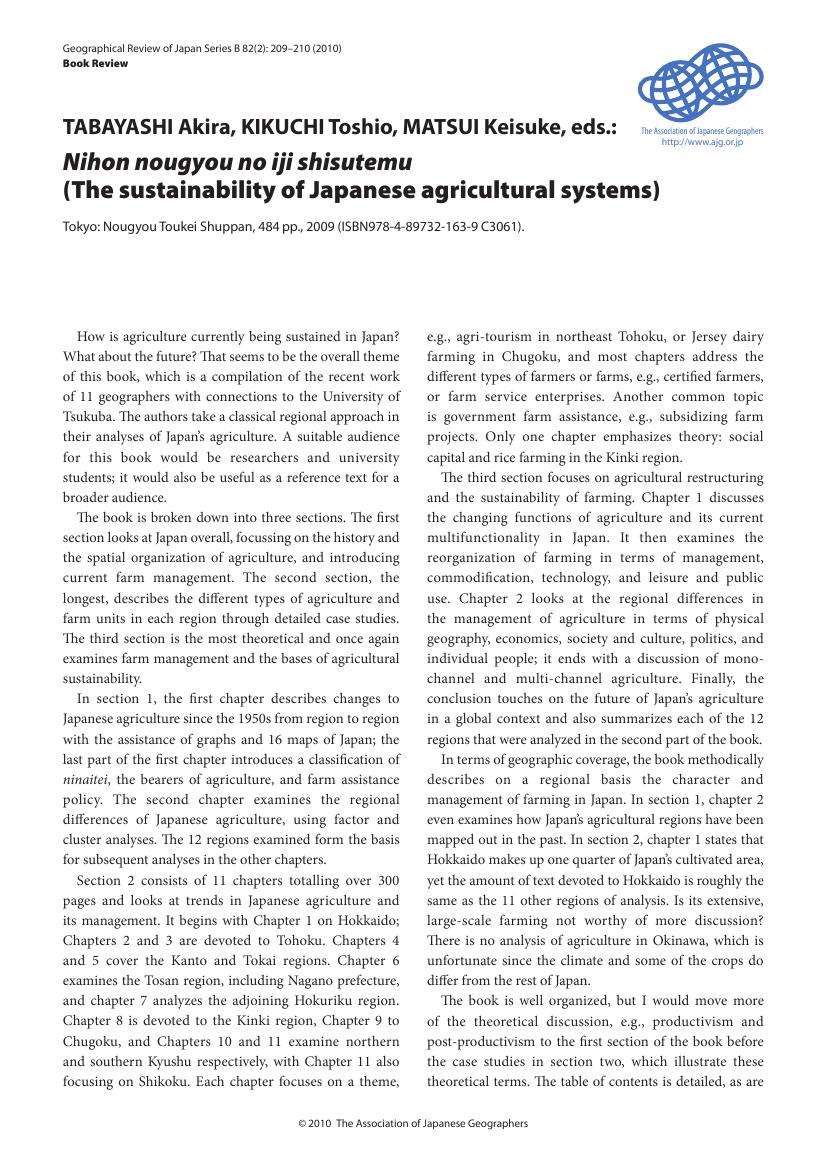- 著者
- Azusa IGUCHI Akira TABAYASHI Tom WALDICHUK Pengfei WANG
- 出版者
- The Association of Japanese Geographers
- 雑誌
- 地理学評論 (ISSN:13479555)
- 巻号頁・発行日
- vol.80, no.12, pp.732-757, 2007-10-01 (Released:2010-03-12)
- 参考文献数
- 33
- 被引用文献数
- 3
This study examines the rejuvenation of greenhouse horticulture on the Kujukuri Plain in Chiba Prefecture, about 60km from Tokyo. Greenhouse horticulture has gone through many changes since the 1990s, and the management of greenhouse operation, in particular, has changed with the introduction of advanced hydroponics and large agricultural subsidies. The study is based on interviews conducted with farmers, employees of agricultural co-operatives and local government officials in 2005 and 2006, and a land-use survey conducted in 2004. We emphasize actors and their linkages in maintaining horticulture, and examine the formation of the following linkages among actors: the linkages among individual farmers voluntarily involved in farm groups, the linkages among groups of farmers, and those between farmers and agricultural co-operatives, farm equipment manufacturers and local governments. The formation of five hydroponic organizations in Shirako Town is studied by examining several factors that help to maintain and develop greenhouse horticulture. These factors are favourable climate, rich soil, the proximity to large markets, accumulated horticultural technology, advanced infrastructure, the increase in profits and the rationalization of farming owing to the innovations adopted by individual farms, and the improvement in farm working conditions. Among various actors, the leaders of each hydroponic organization and the Shirako Hydroponic Association have played an important role and have been a driving force to develop hydroponic horticulture in Shirako Town. Hydroponic farmers have maintained individual farm management while they have created farm associations that take advantage of working in groups. Moreover, these five hydroponic organizations have improved co-operation with agricultural co-operatives, local government, seedling companies and hydroponic equipment manufacturers.
- 著者
- Tom Waldichuk
- 出版者
- The Association of Japanese Geographers
- 雑誌
- Geographical review of Japan series B (ISSN:18834396)
- 巻号頁・発行日
- vol.82, no.2, pp.209-210, 2010-03-30 (Released:2010-05-20)
- 著者
- Tom WALDICHUK
- 出版者
- The Association of Japanese Geographers
- 雑誌
- Geographical review of Japan series B (ISSN:18834396)
- 巻号頁・発行日
- vol.82, no.1, pp.1-13, 2009-08-30 (Released:2009-10-07)
- 参考文献数
- 55
The rural–urban fringe around large cities such as Tokyo contains commuter cities made up of an old-timer population and an increasing number of newcomers, and the literature points out that there are attitude and value differences among these residents. This article therefore examines the different types of healthy, active seniors and how their satisfaction with leisure facilities, services, and activities varies. After outlining the concept of community satisfaction and ikigai (a life worth living) and examining the creation and maturation of bedroom communities in the rural–urban fringe of Japan, I describe the case study area of Ushiku City near Tokyo and its leisure opportunities for seniors. Then, I compare the satisfaction of leisure activities, facilities, and services among retirement-aged residents of Ushiku. This information was obtained by questionnaire in 1997 and through informal interviews in 1996 and 1997. Follow-up interviews with Ushiku City officials took place in 2003, 2006, 2007, and 2008. It was hypothesized that there would be attitude differences between newcomer and old-timer residents. There were, however, few differences between newcomers and old-timers. On the other hand, responses varied according to whether the participant was male or female, and whether the participant lived in a rural or an urban area of Ushiku. The rural–urban differences reflect Ushiku's large area which contains urbanized and rural landscapes. The findings suggest that gender differences and one's residential location are important determinants of community satisfaction and should be considered when planning leisure facilities and services for seniors in these rural–urban fringe commuter settlements.
